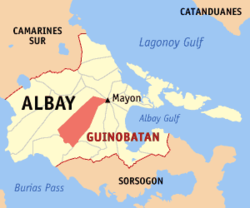Guinobatan
| Guinobatan | ||
|---|---|---|
| Municipality | ||
|
||
 Location within Albay province |
||
| Location within the Philippines | ||
| Coordinates: 13°11′N 123°36′E / 13.18°N 123.6°ECoordinates: 13°11′N 123°36′E / 13.18°N 123.6°E | ||
| Country | Philippines | |
| Region | Bicol Region (Region V) | |
| Province | Albay | |
| District | 3rd district | |
| Barangays | 44 (see Barangays) | |
| Government | ||
| • Type | Sangguniang Bayan | |
| • Mayor | Ann "Gemma" Y. Ongjoco | |
| Area | ||
| • Total | 244.43 km2 (94.37 sq mi) | |
| Population (2015 census) | ||
| • Total | 82,361 | |
| • Density | 340/km2 (870/sq mi) | |
| • Voter (2016) | 48,595 | |
| Time zone | PST (UTC+8) | |
| ZIP code | 4503 | |
| IDD : area code | +63 (0)52 | |
| Income class | 1st class | |
| PSGC | 050504000 | |
| Website | www |
|
Guinobatan, officially the Municipality of Guinobatan (Central Bikol: Banwaan kan Guinobatan; Filipino: Bayan ng Guinobatan), is a municipality in the province of Albay in the Bicol Region (Region V) of the Philippines. The population was 82,361 at the 2015 census. In the 2016 electoral roll, it had 48,595 registered voters.
The town is the birthplace of General Simeón Ola, the last Filipino general to surrender to the Americans after the Philippine-American War.
In the research work "Guinobatan Through the Times," the following version of the legend is stated:
Some versions also state that the town's name is derived from Ginabutan, meaning "a place where trees or plants were uprooted."
Luis Nee, a botanist, reached Bikol in January 1792, accompanying the expedition of Capt. Alejandro Malaspina. Nee explored towns near Mayon and including the area now known as Guinobatan. He noted that "trees grew in exuberance making the foothills impenetrable in many parts."
Dr. Leonilo Palacio of Guinobatan’s Republic Colleges mentioned in an essay entitled "Guinobatan and its Church" that "in 1672, the Parish of Guinobatan was already mentioned in books as a visita of the Municipality of Camalig."
In 1890, the title of the gobernadorcillo was changed to Capitan Municipal. The Municipal Law of 1894 guaranteed that the term of the local executive would be extended from two years to four years. Also among the salient provisions of the law was the election of 12 vocales, equivalent to today’s councilors. In 1895, the Colegio de San Buenaventura was also built, making Guinobatan the centre for higher education in Albay.
Cabezas and principales elected the gobernadorcillo until 1863. Until 1847, Guinobatan belonged to Camarines. During the said year,the towns of Quipia, Camalig and Donsol (now in Sorsogon) were ceded to Albay, in exchange for the towns of the Partido de Lagonoy. From 1730-1818, the town transferred from one place to another. In 1730, it was on a site now called Binanuahan. From there, it was the relocated to Bubulusan. During the eruption of 1814, citizens opted to evacuate to higher ground, in Mauraro.
...
Wikipedia


